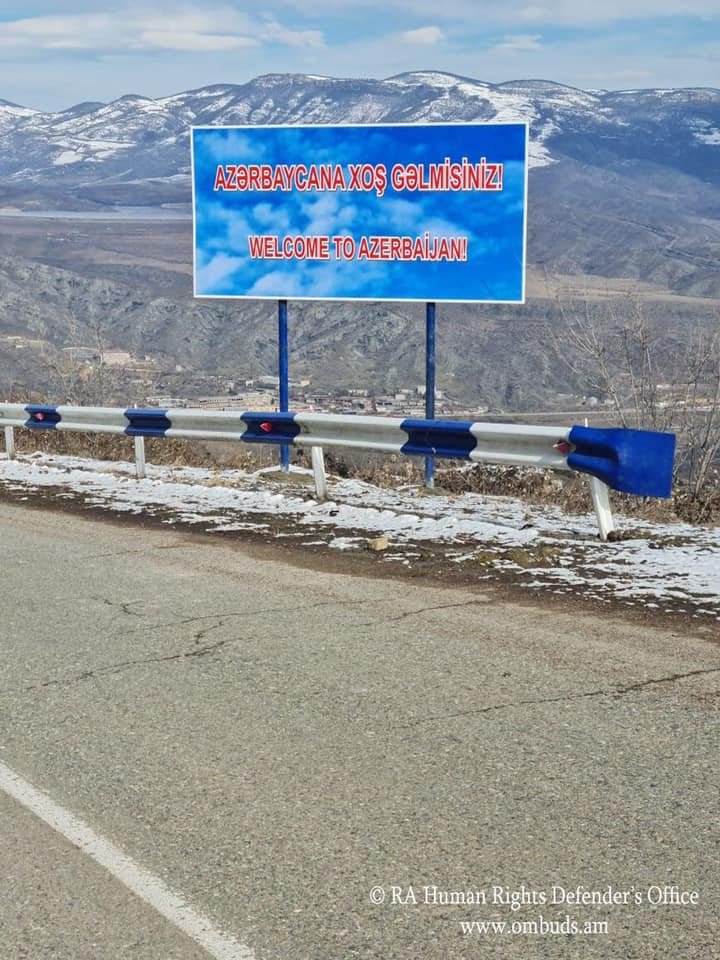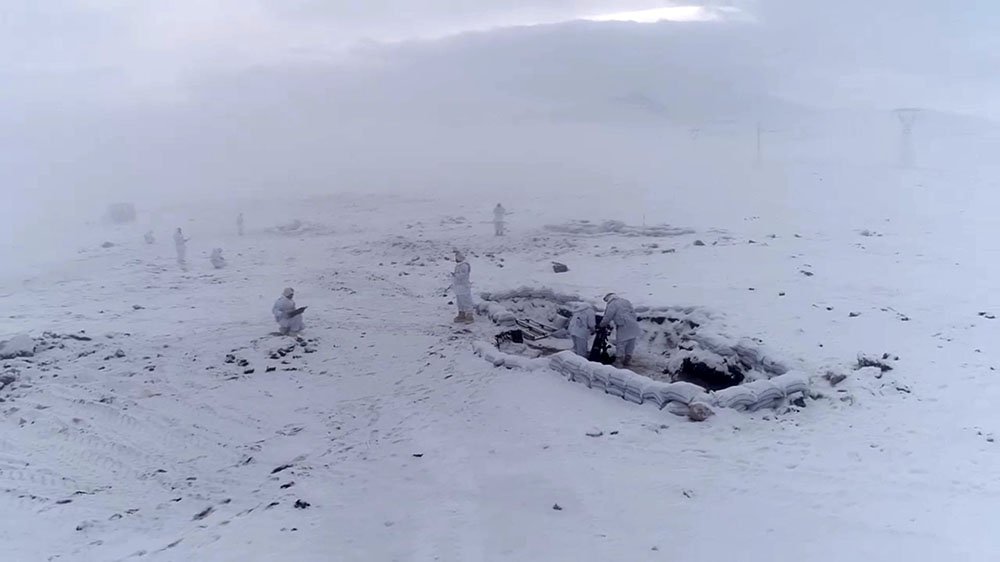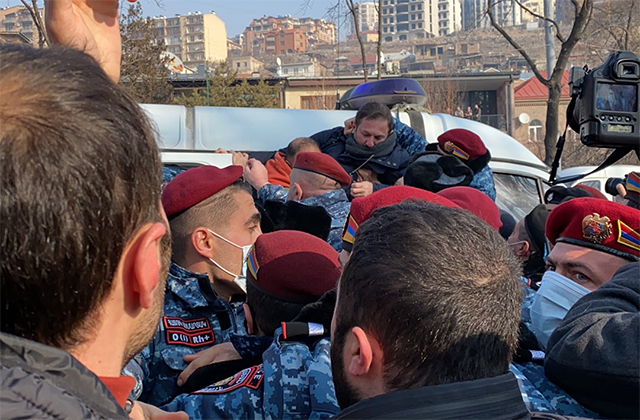The trilateral working group created to oversee the construction of transport links connecting Armenia and Azerbaijan met for the first time on January 30. The meeting follows a summit between the Prime Minister of Armenia and the Presidents of Azerbaijan and Russia on January 11 during which the leaders agreed to unblock all economic and transport links in the region, as per point nine of the November 9 trilateral ceasefire agreement ending the 2020 Artsakh War.

According to the statement released following the January 11 summit, routes that were operational during the Soviet era yet have been closed since the first Artsakh War will be rebuilt. Azerbaijan and its Nakhichevan Autonomous Republic will be connected by a route crossing through the town of Meghri in Armenia’s southernmost Syunik province. Land travel between the two regions has not been possible until now. Armenia will be connected to Russia through Azerbaijan. Presently the only land passage from Armenia to Russia is the Georgian Upper Lars transport corridor, yet this route is often closed due to severe weather conditions. These routes will also provide Russia and Turkey with overland connection through Armenia and Azerbaijan.
The working group to oversee construction is chaired by the respective Deputy Prime Ministers from Armenia, Azerbaijan and Russia: Mher Grigoryan, Shahin Mustafayev and Alexei Overchuk. During its first meeting, the group agreed to establish expert subgroups in rail, road and combined transport and transport security issues, including border, customs, sanitary, veterinary, phytosanitary and other types of control. The subgroups will hold their first meetings by February 5.
Analysts have noted that the unblocking of transport links in the region poses potential advantages and risks for the Armenian economy as well as national security. The agreement offers the possibility for greater economic investment in a landlocked country where economic development has been stymied over the last three decades by a total blockade imposed by Turkey and Azerbaijan since the first Artsakh War. However, prospects for economic growth might be contingent on the future construction of transportation infrastructure. Currently Meghri is not connected by rail to the rest of Armenia, potentially limiting the economic benefits of a Kars-Nakhichevan-Meghri-Zangelan-Baku railway without the expansion of domestic transportation infrastructure or the revival of other regional routes like the Soviet era Kars-Gyumri railway.
The opening of economic and transport links in the region also gives rise to national security concerns. Primarily, while the ceasefire agreement guarantees that the route passing through Armenia will be guarded by Russian peacekeepers, it offers no guarantees regarding the security of Armenian cargo and passengers travelling through Azerbaijan. Moreover, the establishment of transportation and communication links between Armenia and Azerbaijan has been presented as a step toward peacebuilding through regional integration. However, persistent instability along the newly created borders between the two countries indicates the severe obstacles to cooperation. The Office of Armenia’s Human Rights Defender reported that Azerbaijani personnel stationed in Zangelan have been firing in the direction of settlements in Syunik with small and large caliber weapons for the past month. Meanwhile the Azerbaijani military erected a sign stating “Welcome to Azerbaijan” on the inter-community road from Kapan to Chakaten, the second such incident since parts of the Koris-Meghri-Kapan highway came under Azerbaijani control at the end of the war. Such intimidation tactics endanger the security of Armenian residents of border communities while undermining possibilities for peace moving forward.

Finally, progress on regional economic integration is widely perceived as secondary to immediate human rights concerns, such as Azerbaijan’s refusal to return dozens of Armenian prisoners of war and other captives. Armenia and Azerbaijan conducted another partial exchange of prisoners on January 28, yet at least 115 Armenian prisoners remain in captivity.
Armenian Deputy Prime Minister Tigran Avinyan shared that five Armenian prisoners returned home from Azerbaijan on January 28 through the combined efforts of the Russian peacekeeping contingent in Artsakh and the Armenian National Security Service. The soldiers were captured alongside 57 others following an attack by the Azerbaijani armed forces on the Hin Tagher and Khtsabert communities in the southern Hadrut district of Artsakh on December 11—a month after the end of the war. Avinyan also stated that the 62 soldiers had the opportunity to speak with their relatives over the phone for the first time since their capture.
According to Russian military officer and commander of the Russian peacekeepers Rustam Muradov, one Azerbaijani prisoner was also transferred to Baku in the course of the prisoner exchange.
On February 1 United Nations human rights experts published a statement calling for the prompt release of POWs and other captives from the 2020 Artsakh War and the return of bodies to families for burial. “We are alarmed at allegations that prisoners of war and other protected persons have been subjected to extrajudicial killing, enforced disappearance, torture and other ill-treatment,” the experts said. “No exceptional circumstances whatsoever—whether a state of war, internal political instability or any other public emergency—may be invoked as a justification of torture and enforced disappearances…Such acts, when perpetrated in armed conflict, may also constitute war crimes.”
Armenia and Azerbaijan previously exchanged POWs and other captive persons on December 9, 14 and 28, supposedly on an “all-for-all” basis. However, Armenian human rights activists have accused Azerbaijan of artificially protracting the process while withholding information about the identities and health conditions of captive persons. According to human rights lawyer Siranush Sahakyan, there are 120 confirmed cases (and many more unconfirmed) of Armenian prisoners and hostages in Azerbaijan, most of whom were detained after November 9. Meanwhile human rights groups have verified cases of inhuman and cruel treatment of Armenian military troops captured during the war in Azerbaijan.
The Azerbaijani government labels the Armenian prisoners who remain in Azerbaijan terrorists rather than POWs in order to justify their continued captivity. The government has begun to open cases against the 62 soldiers captured in mid-December, alleging that the attacks staged by the Azerbaijani military near Hin Tagher and Khtsabert constituted an anti-terror operation. Armenian officials have condemned such statements, declaring that Azerbaijan violates international humanitarian law while politicizing a human rights issue for its own political and territorial aims.
Meanwhile the Joint Russian-Turkish Center for Monitoring the Ceasefire and All Military Operations in the Conflict Zone opened on January 30. The heads of the defense departments of Russia and Turkey signed a memorandum on November 11, 2020 committing to establish a joint center for the purpose of monitoring compliance with the conditions of the November 9 ceasefire agreement.
The center was established in the Agdam district of Azerbaijan near the Kiyamaddinli settlement. Agdam is one of the 5+2 regions outlying the former Nagorno Karabakh Autonomous Oblast captured by Armenia during the first Artsakh War and returned to Azerbaijan under the terms of the ceasefire. The center is located east of the Russian peacekeeping operation in Artsakh and approximately four miles from the new Line of Contact.
The Joint Russian-Turkish Center will collect, compile and verify information on the observance of the ceasefire through the use of unmanned aerial vehicles. Up to 60 military personnel from each side will be present at the center. Thirty-nine Turkish military personnel have arrived so far.
Turkey has been calling for its inclusion in the conflict settlement process, proposing a 3+3 framework that would include Armenia, Azerbaijan, Russia, Georgia and Iran. Armenian Foreign Ministry Spokesperson Anna Naghdalyan told reporters that a “relevant environment of trust is needed for dialogue” and that recent instances of destruction and misappropriation of Armenian cultural heritage in Turkey delegitimize Turkey’s “calls on cooperation for regional peace and stability.”
The Armed Forces of Turkey and Azerbaijan also commenced large-scale joint military exercises on February 1 in the eastern Turkish province of Kars, which borders Armenia. Following previous military drills in Baku in the summer of 2020, Turkey left military equipment and personnel in Azerbaijan that were later deployed in the war. The military exercises will last until February 12 and will involve air and ground assaults, airdrops, airborne operations and logistics support.

In the domestic sphere, the Homeland Salvation Movement held a demonstration on February 3 to protest the parliamentary meeting agenda, demanding that the “My Step” party address the urgent issues facing the country such as the return of POWs and the reconstruction of the army. The demonstrators gathered outside of the National Assembly Building and marched to Republic Square, shouting “Nikol, Traitor” and “Armenia Without Nikol.” Several protesters were detained by the police, including Yerkir Media director Gegham Manukyan.




Thank you. This is a remarkable summary of the de facto, on the ground, situation.
Azerbaijan *already* has access to Nakhichevan via Iran.
Azerbaijan does not, therefore, require a duplicate route through southern Armenia.
Moreover, Turkey and Azerbaijan are *already* connected via the Turkish-Nakhichevan border, and via Georgia *too*.
Azserbaijan does not lack for routes and neither does Turkey. Let’s understand that, and not be fooled.
In contrast, Armenia’s ONLY link to Artsakh is through Azerbaijbn because that is how Russian dictator Stalin designed it – specifically to create problems for Armenia.
Russia has always had an obligation to fix this for the past several decades but has done *nothing*.
Thus, there is NO analogy between Armenian and Azerbaijan routes.
Finally, what business is it of Russia and Azerbaijan to dictate to Armenia what routes should cross Armenia’s sovereign territory?
And why are Turkish troops part of the Russian monitoring station? This is nothing but an insult and slap in the face to Armenians.
Vae victis. The fruits of 25 years of stagnation and continuously more bizarre political developments, including the election of a western sponsored failed journo with a clear agenda.
Let’s build a railway routes from meghri to Tehran and all the way to the Persian gulf.
Too expensive as it passes through mountainous terrain. It would cost a billion dollars, China was invited to build it but hasn’t gone past the feasibility stage.
“Opening of transport links between Armenia and Azerbaijan” = open theft from the Armenian people and the destruction of their future, benefiting Russians and Turks, and throwing a bone for Armenia to chew on so they can just shut up. This is how ridiculous an inept Armenia’s “leaders” are and have been for the past century, and also the result of zero political say from the traditional Armenian diaspora.
Imagine, a nation which had 30 years to prepare for the day that a war was coming for certain, and all we got was lies, deception, and a blatantly obvious revelation that the war in question had been planned to be a losing war for Armenia from long ago. No, Pashinyan was not the reason, he is nothing, and a scapegoat for the real SOVIET-BRED THIEVES of Armenia under the service of “Mother Russia”. And the fact that Pashinyan is actually still hanging around speaks volumes about the quality of the people of Armenia, the same ones who escaped Armenia in the 90s to live next to us and tell us how they are “authentic” Armenians. Perhaps Pashinyan should stay, Armenia is not actually our country on the traditional diaspora, and he is the perfect representative of what kind of people live in Armenia: poor, hungry, desperate, know-it-all, bigoted against other Armenians and ignorant. Armenia would have a chance if these were the 25 percent. Instead they are the 75 percent.
I toy with the idea that we in the traditional diaspora need to abandon this thieves den calling itself Armenia, and form our own western nation, even if it is not in our ancestral land, and free of these thieves and their backwards, self-serving unpatriotic mentality.
this is a noose around the Armenians yet to be tightened…